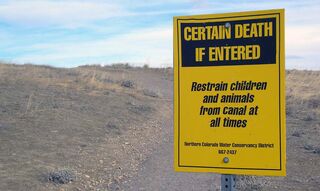Psychology
Enhancing Warnings to Stop Disasters
A new report aims to apply knowledge from the psychology of warnings
Posted January 8, 2022 Reviewed by Vanessa Lancaster
Key points
- We know enough to make disaster warnings fully effective, but we face implementation barriers.
- Key characteristics for successful warnings are accuracy, flexibility, timeliness, and transparency.
- Previous tsunami disasters demonstrate problems and solutions in warnings as social processes.
To learn from well-established knowledge on the psychology of disaster warning, we at the world’s only Warning Research Centre the-worlds-first-warning-research-center-has-opened have just published a report on “Enhancing Warnings.” Commissioned by the UK’s National Preparedness Commission, it offers the country and the world advice and direction on doing better with warnings based on what we know already about people’s understandings for, perceptions of, and responses to disaster risks.

Paramount is the voluminous pre-2020 knowledge that pandemics happen, they display high risks, and early detection and response can avert them. Yet still, COVID-19 stopped the world and continues to affect daily lives negatively, despite effective vaccines and extensive previous experience of stopping diseases. Founded on sciences including behavior change, cognition, pedagogy, and resilience, the report links disaster research with examples of warnings that succeeded and failed.
Our “Enhancing Warnings” report begins with the point that a warning is a long-term process, starting by assessing people’s knowledge and information needs regarding possible threats and responses. The three E’s are developed: Education, Exchange, Engagement. To succeed, we need the three I’s: Imagination, Initiative, Integration. We guide the implementation of these trios through recommendations highlighting how to make warnings actionable and actioned through accuracy, flexibility, timeliness, and transparency.
Pacific Ocean Tsunamis
All these warning ideas are deep-rooted. On 27 March 1964, one of the largest earthquakes ever recorded rocked southern Alaska and sent tsunami waves radiating across the largest ocean, the Pacific.
A 1969 study compared the tsunami warning and response in Hilo, Hawai’i, which experienced no casualties, and Crescent City, California, where eleven people died alongside extensive property damage.
The paper’s author, William A. Anderson, attributed the difference to the psychology of planning, communication, and action. Hilo had a plan, and residents displayed high awareness of tsunami threats and response actions, whereas Crescent City lacked both. Anderson referred to “disaster warning as a process,” indicating the variety of people and organizations who must be involved in numerous, interrelated activities which will produce a successful warning.
How do we achieve a good warning process? For 1964, it was steeped in recent history. Hilo had been devastated by a tsunami in 1960, killing 61 people, and had learned from it. Then, in February 1965, another earthquake rocked Alaska leading to tsunami alerts for Crescent City. The response implemented many lessons from 1964’s errors in terms of a swifter reaction speed, people knowing what to do, and being motivated to act suitably. In the end, no tsunami appeared with little evidence of resentment against the warning.
Indian Ocean Tsunamis
This experience did not inevitably assist others around the globe. Soon after the 1964 waves, efforts were documented to emulate the Pacific Tsunami Warning Center for the Indian Ocean. Previous tsunamis had crossed the Indian Ocean, such as during the 1883 volcanic eruptions of Indonesia’s Krakatoa, where many people live by the coast. Since Pacific tsunami warnings had worked, the Indian Ocean deserved a similar process.
Advocates proposed plans and sought funds. Little was done—until just after it was too late for many. On 26 December 2004, a massive earthquake off Indonesia’s coast generated waves rippling for hours. The Pacific Tsunami Warning Center recorded the earthquake and immediately realized the potential for a lethal tsunami. They did their best to send alerts, but warning is a long-term three E’s and three I’s process that cannot start after a threat materializes.
Throughout a dozen countries, around 250,000 people died. Meanwhile, hundreds survived when the individual or collective knowledge recognized local tsunami signs and cleared beaches. They were part of the tsunami warning process in one Indonesian location by passing knowledge down through generations and on one Thai beach due to a child having learned about tsunamis two weeks prior.
Eighteen months after the catastrophe, the Indian Ocean Tsunami Warning System became operational. Gaps have since been identified, and parts are falling into disrepair. How quickly we forget and neglect.
Remembering Warnings
So perhaps “Enhancing Warnings” is “remembering warnings”—remembering that we need them, that they are a continual social process, and that they must be connected tangibly to people’s day-to-day lives. As our new report explains, warnings “frequently fail because people do not act or act ineffectively.” To avoid this problem repeating, forewarnings always start with people, their perspectives, and their needs.
References
Anderson, W.A. 1969. Disaster warning and communication processes in two communities. Journal of Communication, vol. 19, no. 2, pp. 92-104.
Fearnley, C. and S. Beaven. 2018. Volcano Alert Level Systems: Managing the Challenges of Effective volcanic Crisis Communication. Bulletin of Volcanology, vol. 80, no. 5, pp. 1-18.
Fearnley, C. and I. Kelman. 2021 (December). Enhancing Warnings. National Preparedness Commission, London, U.K.
Kelman, I. 2006. Warning for the 26 December 2004 Tsunamis. Disaster Prevention and Management, vol. 15, no. 1, pp. 178-189.




